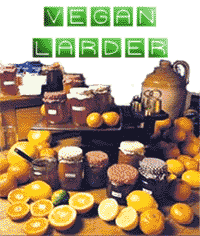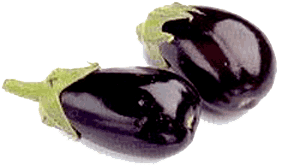|
The Lazy Vegan:
Aubergine / Brinjal / Eggplant
The Apple of Sodom
 by Robert Allen and Martina Watts
by Robert Allen and Martina Watts
Solanum melongena: An Asian delicacy thought to be native
to modern Burma, the aubergine upset the sensibilities of
western physicians when it reached Europe in the middle
ages and until the late 19th century was still being grown
as an ornamental plant. A member of the Solanaceae family
(pepper, potato, tomato), these ignorant doctors claimed it
caused fevers and fits. Carl Linnaeus, the Swedish
botanist, named it Solanum insanum because of its
reputation and then changed his mind and gave the vegetable
its modern name - Solanum melongena.
|
 Foods to be kept in constant stock:
Beans:
Beans (tinned, dried and fresh):
Foods to be kept in constant stock:
Beans:
Beans (tinned, dried and fresh):
haricot (aka baked) beans
blackeyed peas
chick peas
fava (broad) beans
soya beans
kidney beans
runner beans
peas
Bean sprouts
Soya curd (tofu)
Biochemical:
Calcium fluoride
Sodium chloride
Sodium sulphate
Silica
Condiments:
Black Strap Molasses
Fermented and pickled foods, especially
miso (soy and barley)
salted black beans
chinese cabbage
Organic vegetable stock
Peanut butter
Sauerkraut
Soya Sauce
Mushroom (Pearl River brand)
Thick (Pearl River brand)
Thin (Pearl River brand)
Japanese (any)
Yeast extract
Yoghurt
Fruit (dried and fresh):
Apple
Apricot
Banana
Chilli
Fig
Lemon
Orange
Peach
Pear
Pineapple
Prunes
Tomato (tinned, dried and fresh)
Grains:
Barley (including flakes as cereal)
Cracked wheat/bulgar
Oats (including flakes as cereal)
Polenta (dried maize/corn)
Rice (brown and white)
Rye
Wheat (including flakes as cereal)
Wheat germ (including as cereal)
Herbs (dried and fresh):
Angelica
Balm
Basil
Camomile
Chive
Comfrey
Cress
Echinacea
Lovage
Marjoram
Mint
Nettle
Oregano
Parsley
Rosemary
St John's Wort
Tarragon
Thyme
Legumes/Lentils/Peas:
Dal (lentils)
chana
toor
urid
Legumes
Peas
Liquids/Tissanes:
Balm (leaves)
Borage (leaves and flowers)
Camomile (flowers)
Nettle (young leaves)
Rosehip (fruit, including seeds, skin and pulp)
Sage (leaves)
Soya milk
St John's Wort (leaves and flowers)
[freshly made fruit juices]
[vegetable water, retained after boiling potatoes, etc]
Nuts:
Almond
Hazelnut
Walnut
Oils:
Olive
Sesame
Sunflower
Roots:
Arnica
Carrot
Dandelion (including dried, roasted and ground to make
coffee)
Garlic
Ginger
Horseradish
Onion
Potato
Shallot
Seeds:
Asafoetida (also a root)
Cardamon
Cinnamon
Clove
Coriander
Cumin
Fennel
Fenugreek
Mustard
Nutmeg
Peppercorns (black, green, red and white)
Pumpkin (including as cereal, and ground in bread)
Sesame
Tumeric (also a root)
Seed sprouts
Sunflower (including as cereal, and ground in bread)
Vegetables:
Brocolli (including sprouting brocolli)
Cabbage
Caulifower
Chard
Courgettes
Dandelion
Leek
Spinach (tinned and fresh)
Sea:
Carrageen (aka Irish moss)
Dulse/Dillisk
Kombu (aka Kelp)
Nori (aka Laver)
Wakame (aka Kelp)
Wild food:
Blackberries
Blueberries
Redberries
Cherries
Blackcurrants
Redcurrants
Whitecurrants
Damsons
Gooseberries
Hawthorn
Juniperberries
Loganberries
Mushrooms
Raspberries
Rosehip
Rowanberries
Strawberries
Other:
Breads
Noodles
Couscous
Pasta
|
|
|
Brought into the eastern Mediterranean region by the Arab
caravans that travelled to and from the Far East, the
aubergine with its distinct fried oyster flavour became
popular among the Moors of northern Africa.
When they invaded Spain in the 12th century they introduced its seeds
to the slightly colder climate. It thrived in the porous
well-drained soil and was soon grown all over western
Europe but doctors were convinced it was poisonous, calling
it 'the mad apple' and 'the apple of sodom'.
The wiser people of the Middle East knew it for what it was
- 'poor man's meat' or 'poor man's cavier' - and today the
aubergine is a popular favourite in southern Italy,
southern Spain, south-eastern France, Turkey, Greece and
the Middle Eastern countries, where it is still known by
the name the Catalans called it - berengenas - 'apples of
love' because it was thought to be a love potion. It's not.
All the way from the European lands through the Middle East
by way of Israel, Lebanon, Palestine, Syria, the Maghreb of
north Africa and into Turkey, Iran, Iraq, Kurdistan,
Pakistan, India, China and Japan - where it is among the
most popular national dishes - the aubergine has been
adapted into national cuisine.
Known for thousands of years in Asia by its various native
names, the Arabs called it al-babinjan, the Spanish
alberginia and later berengenas, the French and British
aubergine, the Italians melanzane, the Greeks melitzane
while it is popularly known as brinjal in south-east Asia.
Because it was shaped like a goose egg it became popularly
known in English speaking countries, particularly north
America, as eggplant.

Modern nutritionists know the aubergine as an essential
vegetable that:
- lowers cholesterol,
- aids the digestive system, combating constipation
- stimulates the liver and intestine and generally helps the body deal with internal
problems
Despite being 90 percent water for every 100
grams and low in protein (just one gram), the aubergine is:
- rich in calcium,
- iron,
- niacin,
- phosphorus,
- potassium, plus
- vitamins PP,
- A,
- B1
- and B2.
And, like all popular vegetables (though in fact it is a
fruit), the aubergine has its own story, which emanates from
the East, probably India, where the British first
encountered its nutritional and medicinal properties:
A long time ago, perhaps around the time of the one
thousand and one nights, a young girl known as a good cook
was selected by an Imam for marriage.
As a dowry the priest
asked her father for 12 large jars of virgin olive oil.
Returning from her wedding, the girl cut up many brinjal
and left them to soak in the olive oil her father had put
aside for her dowry, but after 11 days the brinjal had
soaked up all the oil.
When the Imam saw this he fainted.
This is why many restaurants serve brinjal fried in oil and
call it 'Imam Bayildi' - in English 'the priest fainted'.
Once on a mid-day train from Foggia to Napoli in Italy my
lunch was young spinach leaves, baked aubergine in
breadcrumbs and spices, mozzarella, sundried tomatoes,
fresh tomatoes, pumpkin seeds, olive oil and chilli sauce.
All these were acquired in a supermercato in Foggia but the
delight was the baked aubergine. I suspect the recipe was
simple. Thick slices of aubergine were baked in the oven
covered with a layer of olive oil and breadcrumbs sprinkled
with ground paprika or chilli.
Because of its popularity aubergine recipes number in the
thousands. Most people are familiar with aubergine in
moussaka and in ratatouille, and while these are fine vegan
dishes they only hint at the richness of the aubergine
platter. The aubergine can be boiled, baked, cooked in oil,
steamed and roasted, and added to other vegetables (and
dare I say it meats) in various combinations.

Here is our modest contribution but before you cook the
aubergine take a look at the Belladona plant, the queen of
the Deadly Nightshade family, and look at their similarity.
Now you'll know why European doctors were suspicious.
Aubergine and potato bake
Deep baking tray or oven proof dish
Olive oil
Two large aubergines, cut along their length into half inch
thick slices, salt and leave for an hour, rinse salt away
and dry. Or a dozen small aubergines (of the Asian
variety), cut into thick slices.
Four large waxy potatoes, cut into quarter inch slices.
Two large onions, cut into thin slices.
Two tins of plum tomatoes.
Ground paprika
Layer the potatoes in the tray on a film of olive oil,
place the onions on top and finally the aubergines.
Add several spoonfuls of olive oil until the aubergines are
soaked.
Sprinkle the paprika over the aubergines, as little
or as much as you like.
Bake for 30 minutes on a moderate
heat, and then add the tomatoes and cook until the potatoes
are done.
Serve with couscous.

So now I suppose you'll want to know how to grow them
yourself?
Couldn't be easier. If you are in a cold climate
start the seeds indoors or in a greenhouse or polytunnel,
setting outside after all danger of frost has gone. The
seeds should be planted two months before the usual date
for the end of the frost. In hot climates they can be set
out as soon as the soil warms.
Aubergines need at least five months of hot weather with
day temperatures no lower than 80 degrees, and night no
lower than 70 degrees. In colder climates when the
aubergine seedlings are planted out it is wise to keep them
under cloches until the weather reaches a constant high
temperature.
Aubergine seeds should be soaked before they are planted,
in rich porous soil that drains well and has a ph of 6 to
7. A mulch should be added to the soil around the plants.
This will help retain moisture and make it available to the
plant and help suppress unwanted vegetation.
Aubergines come in several eggshapes and numerous colours.
The large elongated eggshaped glossy deep purple aubergine
is the most common and it might surprise some people to
learn that the fruit also comes in black, green, yellow and
white. And that the aubergine prized by chefs and those
natives in the know is the small purple variety set by
growers in India.
Like its family the aubergine needs constant feeding.
Liquid compost and seaweed will help its initial growth.
Once the fruits emerge regularly feed with liquid compost.
Author: English physician with a deadly imagination
- – Robert Allen and Martina Watts
![]()
The above is an extract from the book The Lazy Vegan, publication date TBA
|
|
 by Robert Allen and Martina Watts
by Robert Allen and Martina Watts




